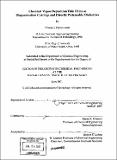| dc.contributor.advisor | Karen K. Gleason. | en_US |
| dc.contributor.author | Pryce Lewis, Hilton G. (Hilton Gavin), 1973- | en_US |
| dc.contributor.other | Massachusetts Institute of Technology. Dept. of Chemical Engineering. | en_US |
| dc.date.accessioned | 2005-09-26T19:18:06Z | |
| dc.date.available | 2005-09-26T19:18:06Z | |
| dc.date.copyright | 2001 | en_US |
| dc.date.issued | 2001 | en_US |
| dc.identifier.uri | http://hdl.handle.net/1721.1/28237 | |
| dc.description | Thesis (Ph. D.)--Massachusetts Institute of Technology, Dept. of Chemical Engineering, 2001. | en_US |
| dc.description | Includes bibliographical references. | en_US |
| dc.description.abstract | Organosilicon thin films deposited by pulsed plasma-enhanced chemical vapor deposition (PPECVD) and hot-filament chemical vapor deposition (HFCVD) were investigated as potential biopassivation coatings for neural probes. It was found that organosilicon films from identical precursors differ in structure according to the method of deposition. For films produced from the cyclic siloxane precursor, hexamethylcyclotrisiloxane, pulsed plasma excitation reduced crosslink density over continuous excitation and produced flexible films resistant to prolonged saline soak testing. Deposition via a thermal process, HFCVD, allowed films of novel organosilicon structure to be formed from both hexamethylcyclotrisiloxane and its eight-membered analog, octamethylcyclotetrasiloxane. Characterization of these films was accomplished, and the effect of filament temperature on the chemical structure was elucidated. Silicon-silicon bonding and the retention of ring structures from the precursor was observed in HFCVD organosilicon films using Micro-Raman spectroscopy. A direct dielectric patterning process was proposed for semiconductor manufacturing. In this process, a dielectric material is patterned directly and developed without the need for a sacrificial photoresist layer. HFCVD fluorocarbon films are under consideration as low-dielectric constant interlayer dielectrics, and direct patterning of these materials was demonstrated using e-beam irradiation and supercritical CO2 development. The use of a gas-phase initiator species for HFCVD of fluorocarbon thin films was also demonstrated. Initiation enhanced deposition rates significantly and provided a means of selectively end-capping polymer chains present in the film structure. | en_US |
| dc.description.statementofresponsibility | by Hilton G. Pryce Lewis. | en_US |
| dc.format.extent | 127 leaves | en_US |
| dc.format.extent | 6851271 bytes | |
| dc.format.extent | 6867815 bytes | |
| dc.format.mimetype | application/pdf | |
| dc.format.mimetype | application/pdf | |
| dc.language.iso | en_US | |
| dc.publisher | Massachusetts Institute of Technology | en_US |
| dc.rights | M.I.T. theses are protected by copyright. They may be viewed from this source for any purpose, but reproduction or distribution in any format is prohibited without written permission. See provided URL for inquiries about permission. | en_US |
| dc.rights.uri | http://dspace.mit.edu/handle/1721.1/7582 | |
| dc.subject | Chemical Engineering. | en_US |
| dc.title | Chemical vapor deposition thin films as biopassivation coatings and directly patternable dielectrics | en_US |
| dc.type | Thesis | en_US |
| dc.description.degree | Ph.D. | en_US |
| dc.contributor.department | Massachusetts Institute of Technology. Department of Chemical Engineering | |
| dc.identifier.oclc | 49560096 | en_US |
